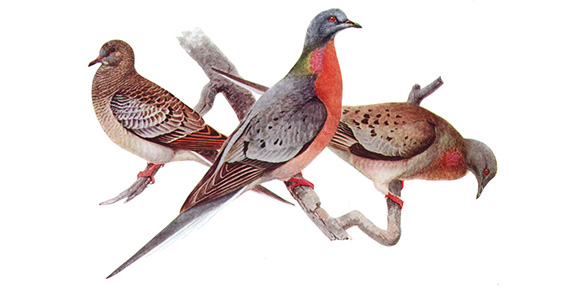by Bruce Cherney (part 5)
When decimating nesting sites, commercial hunters put their passenger pigeon bounty into barrels and shipped them east. New York City could absorb 100 barrels of pigeons a day, each barrel holding 500 to 600 birds. The pigeon’s were sent to the city’s fancy restaurants, such as Delmonico’s, where Ballotine of Squab à la Madison and Pigeon à la Lombardy was featured on the menu.
Tracing the 1871 journey made by squabs destined for Demonico’s in New York from the La Crosse Valley in Wisconsin, Jennifer Price in her book, Flight Maps: Adventures with Nature, 1999, wrote that it began with an 12-kilometre ride from the nesting site to the Sparta rail depot. The squab were packed in barrels with ice and shipped on the Milwaukee-St. Paul express train to Milwaukee and then to Chicago, where the barrels were transferred to the Chicago, Burlington and MO express train to New York City. A driver for the American Merchant’s Union Express picked up the barrels at Grand Central Station and delivered the barrels to a game dealer, who had purchased the squabs from a Chicago game dealer on commission.
“The largest, best-stocked stalls (for pigeons) in New York were in the Washington and Fulton outdoor markets. Fulton market was home to dealer Amos E. Robbins, who supplied New York’s finest restaurants, most notably Delmonico’s.”
Properitor Lorenzo Delmonico went to the market at 4 a.m. each morning to choose the freshest squabs, which then travelled in his wagon to Fulton and South streets up Broadway to 14th Street and were unloaded at the kitchen of his Fifth Avenue restaurant at 8 a.m.
From nesting grounds to restaurant, the trip took two days.
The Allen brothers, Joseph and Isaac, of Manchester, Michigan, described the marketing of pigeons, as related in The Passenger Pigeon, by William Butts Mershon, and published in 1907.
They said their father, another pigeon hunter, otherwise known as a pigeoner, “advised us to dispose of them for 25 cents per dozen; this was the highest price pigeons were worth in Adrian (Michigan). To please him we tried to sell them for that price, but could not, so, taking them to the express office, we shipped them (by rail). In about four days the returns came, netting us 70 cents per dozen, about the lowest price we ever got. They explained that the pigeons had been poorly handled or they would have brought more. This was thirty-five years ago, and these were probably the first pigeons shipped from this State to New York.
“We have shipped thousands since. They would probably average $2 per dozen. We have sold them as high as $3.75 per dozen and have seen them quoted as high as $6 per dozen. A pigeoner from Pennsylvania told us he shipped two barrels at one time and got $5.50 per dozen. We caught 2,400 one week, having them all on hand at one time. We got a market report from New York where they were quoted at $6.50 per dozen. We packed and shipped ours as soon as possible. When they reached market they sold for $1.50 per dozen. The army of pigeoners had struck a big nesting in the State of Wisconsin the same week we caught ours, and they shipped them to market by the wholesale. The market dropped from $6.50 to $1.25 in one week.
The brothers said as many as 500 barrels were shipped to New York and Boston in one day. “Our commission man in New York wrote us that 100 barrels a day could be sold there without affecting the market but very little ...
“The young pigeons (squabs) were much sought after in New York and Boston, and if sent in moderate numbers brought big prices, usually about two dollars per dozen. When the squabs were old enough to market, the army of pigeoners (estimated to be about five hundred) commenced taking them. Entering the woods in which the nesting was located, they cut down the trees right and left, cutting the timber over thousands of acres. When a tree fell, bringing with it the squabs, they picked the young birds up, sometimes getting as many as two dozen from one tree. The large trees, which might have yielded fifty or a hundred, were left standing. Our company of five took in two days thirteen barrels of squabs, averaging 400 to the barrel.”
It was reported that one Boston restaurant alone received 32,400 birds (Forest and Stream, April 11, 1878).
Alexander Wilson wrote in his book, American Ornithology, that the ground at a nesting site being culled by hunters was strewn “with broken limbs of trees, eggs and young squab pigeons, which had been precipitated from above and upon which herds of hogs were fattened. Hawks, buzzards and eagles were sailing about in great numbers, seizing squabs from their nests at pleasure, while from twenty feet upward to the tops of trees, the view through the woods presented a perpetual tumult of crowding and fluttering multitudes of pigeons, their wings roaring like thunder, mingled with the frequent crash of falling timber, for now the axemen were at work, cutting down those trees which seemed to be the most crowded with nests ... the falling of one tree sometimes produced 200 squabs ...”
(Next week: part 6)



